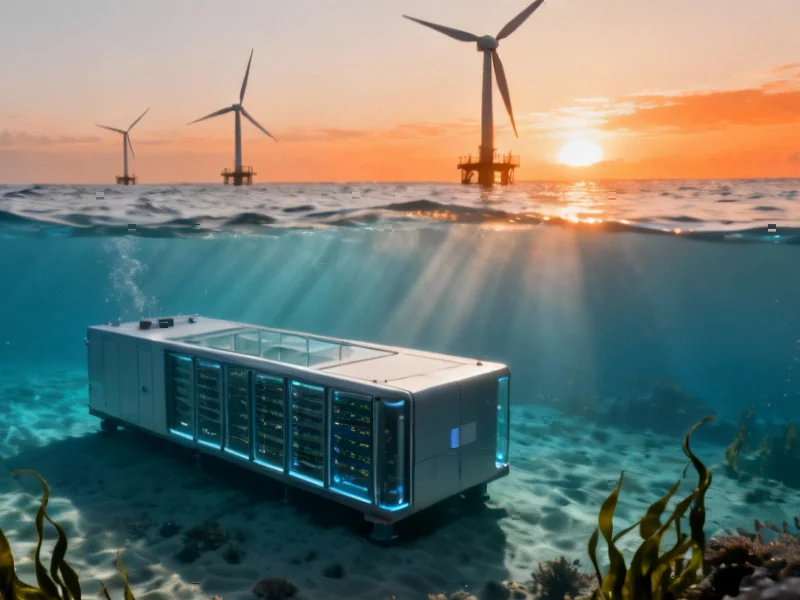Revolutionizing Sustainable Computing Infrastructure
China has officially launched the world’s first underwater data center powered primarily by offshore wind energy, marking a significant milestone in sustainable computing infrastructure. Located in the Lin-gang Special Area of Shanghai Pilot Free Trade Zone, this ¥1.6 billion (US$226 million) project represents a groundbreaking approach to reducing the environmental impact of data centers while maintaining high-performance computing capabilities.
Table of Contents
- Revolutionizing Sustainable Computing Infrastructure
- Green Energy Integration and Efficiency Gains
- Advanced Cooling Technology and Performance Metrics
- Computing Applications and Strategic Importance
- Expansion Plans and Industry Context
- Technical Challenges and Future Development
- Broader Industry Implications
Green Energy Integration and Efficiency Gains
The facility achieves remarkable sustainability metrics, with over 95% of its power coming from offshore wind generation. This renewable energy integration, combined with natural seawater cooling, enables the center to reduce total power consumption by approximately 22.8% compared to traditional land-based data centers. The project completely eliminates freshwater consumption and reduces land use by more than 90%, addressing two critical environmental concerns associated with conventional data centers.
According to industry analysis, traditional data centers can consume up to five million gallons of water daily for cooling purposes – equivalent to the daily water consumption of a town with 10,000 to 50,000 residents. The underwater approach fundamentally reimagines this equation by leveraging the ocean’s natural thermal properties.
Advanced Cooling Technology and Performance Metrics
The cooling system represents one of the project’s most significant innovations. While conventional data centers typically allocate 40-50% of their total power consumption to cooling systems, the underwater facility reduces this to below 10% through direct seawater cooling. The completed Phase 1 installation has achieved a Power Usage Effectiveness (PUE) rating of no higher than 1.15, substantially outperforming China’s national requirement of 1.25 for large-scale data centers by 2025.
Computing Applications and Strategic Importance
Beyond mere data storage, the underwater data center is designed to support advanced computational workloads including artificial intelligence training, high-performance computing, 5G infrastructure, industrial IoT, and e-commerce applications. The facility serves as critical infrastructure for international data flows and represents China’s commitment to developing next-generation computing capabilities with reduced environmental impact., as comprehensive coverage
Expansion Plans and Industry Context
The current 2.3-MW demonstration facility represents only the initial phase of development. Phase 2 plans call for scaling the operation to 24 MW capacity, though specific timelines remain undisclosed. This project follows China’s earlier deployment of a commercial underwater data center in Hainan Province, distinguishing itself through its integration with offshore wind power generation.
Technical Challenges and Future Development
Despite the promising start, engineers acknowledge that significant challenges remain before widespread adoption becomes feasible. Wang Shifeng, chairman of China Communications Construction Company’s Third Harbor Engineering, noted that “construction of UDCs is still in its initial stage” and that achieving the transition from demonstration projects to large-scale application will require continued progress in technological maturity and cost optimization.
Key concerns include long-term maintenance costs, corrosion management in marine environments, and potential ecological impacts. These factors will be closely monitored as the technology progresses from prototype to full-scale implementation.
Broader Industry Implications
The successful deployment of wind-powered underwater data centers comes as the Shanghai municipal government announces ambitious plans to scale its intelligent computing cloud industry by more than ¥200 billion by 2027, targeting 200 EFLOPS of computing capacity. This project demonstrates how sustainable design principles can be integrated with high-performance computing requirements, potentially setting new standards for the global data center industry.
As digital infrastructure continues to expand globally, the Lin-gang project offers a compelling model for reducing the environmental footprint of computing while meeting growing demand for AI training, cloud services, and data processing capabilities.
Related Articles You May Find Interesting
- Samsung’s Galaxy XR Headset Challenges Apple with Google AI and Qualcomm Power i
- Data Center Acquisition Faces Headwinds as AI Infrastructure Market Heats Up
- Windows 11 Release Preview Unveils Revamped Start Menu and Key System Enhancemen
- Genetic Paradox: How Obesity-Causing Mutations May Shield Heart Health
- Takeda Forges $11.4 Billion Oncology Partnership with China’s Innovent Biologics
References & Further Reading
This article draws from multiple authoritative sources. For more information, please consult:
- https://www.eesi.org/articles/view/data-centers-and-water-consumption
- https://www.independent.co.uk/news/oracle-abilene-chatgpt-openai-donald-trump-b2832331.html
- https://english.news.cn/20251021/0a21a82fbcc547369244bd3662be7cbd/c.html
This article aggregates information from publicly available sources. All trademarks and copyrights belong to their respective owners.
Note: Featured image is for illustrative purposes only and does not represent any specific product, service, or entity mentioned in this article.




xvktxl